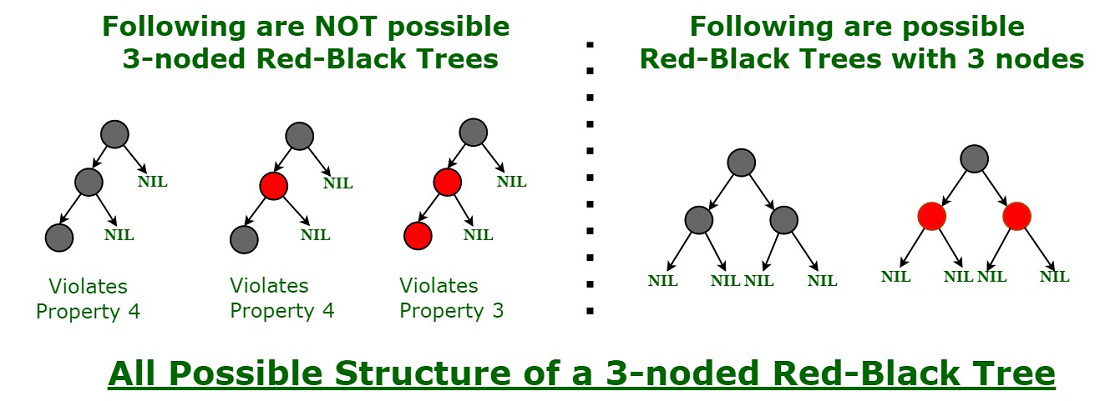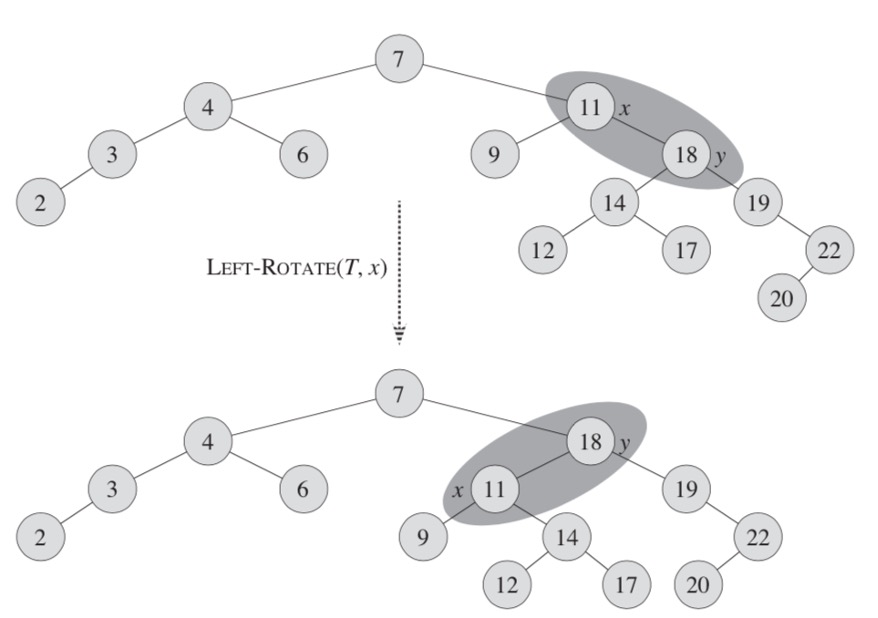Red-Black Tree

- it is a self-balancing binary search tree with one extra bit of storage per node
- its color can be either RED or BLACK
- By constraining the node colors on any simple path from the root to a leaf
- red-black trees ensure that no such path is more than twice as long as any other, so that the tree is approximately balanced
- Each node of the tree contains the attributes
- color, value, left, right, and parent
- If a child or the parent of a node does not exist, the corresponding pointer attribute of the node contains the value null
- We regard these nulls as being pointers to leaves (external nodes) of the binary search tree and the normal, key-bearing nodes as being internal nodes of the tree
- it is a binary tree that satisfies the following red-black properties
- Every node is either red or black
- The root is black
- all leaf node are black
- If a node is red, then both its children and parent are black
- Every path from a node (including root) to any of its descendants NULL nodes has the same number of black nodes
- it also has a lemma
- a tree with n internal nodes has height at most
2log (n + 1)
- a tree with n internal nodes has height at most
Why Red-Black Trees?
- Most of the BST operations (e.g., search, max, min, insert, delete.. etc) take
O(h)time where h is the height of the BST - The cost of these operations may become
O(n)for a skewed Binary tree - If we make sure that the height of the tree remains
O(log n)after every insertion and deletion- then we can guarantee an upper bound of
O(log n)for all these operations
- then we can guarantee an upper bound of
- The height of a Red-Black tree is always
O(log n)where n is the number of nodes in the tree
| Method | Time Complexity |
|---|---|
| Search | O(log n) |
| Insert | O(log n) |
| Delete | O(log n) |
Comparison with AVL Tree
- The AVL trees are more balanced compared to Red-Black Trees
- but they may cause more rotations during insertion and deletion
- if the application involves frequent insertions and deletions
- then Red-Black trees should be preferred
- if the insertions and deletions are less frequent and search is a more frequent operation
- then AVL tree should be preferred over the Red-Black Tree
How does a Red-Black Tree ensure balance?

Applications:
- Most of the self-balancing BST library functions like map, multiset, and multimap in C++ ( or java packages like java.util.TreeMap and java.util.TreeSet ) use Red-Black Trees
- It is used to implement CPU Scheduling Linux
- Completely Fair Scheduler uses it
- It is used in the K-mean clustering algorithm in machine learning for reducing time complexity
- MySQL also uses the Red-Black tree for indexes on tables in order to reduce the searching and insertion time
Insert and Delete

search-tree operations
TREE-INSERTandTREE-DELETE- when run on a red-black tree with n keys, take
O(log n)time- Because they modify the tree, the result may violate the red-black properties
- To restore these properties, we must change the colors of some nodes in the tree and also change the pointer structure
- when run on a red-black tree with n keys, take
We change the pointer structure through rotation
- which is a local operation in a search tree that preserves the binary-search-tree property
- When we do a left rotation on a node x
- we assume that its right child y is not null
- x may be any node in the tree whose right child is not null
- The left rotation "pivots" around the link from x to y
- It makes y the new root of the subtree, with x as ys left child and ys left child as xs right child
rotate left example

- rotating element x in a tree T left
- After a rotation, the y element "pulls" its right subtree up (elements 19, 20, 22)
- Left subtree of x (9) stays the same, and left subtree of y becomes right subtree of x
rotateLeft() {
let y = this.right;
this.right = y.left;
if (!y.left.isNil) {
y.left.parent = this;
}
if (!y.isNil) y.parent = this.parent;
if (this.parent) {
if (this.id === this.parent.left.id) {
this.parent.left = y;
} else {
this.parent.right = y;
}
} else {
this.tree.root = y;
}
y.left = this;
if (!this.isNil) this.parent = y;
}- rotating element x in a tree T left
rotate right example
rotateRight() {
let y = this.left;
this.left = y.right;
if (!y.right.isNil) {
y.right.parent = this;
}
if (!y.isNil) y.parent = this.parent;
if (this.parent) {
if (this.id === this.parent.right.id) {
this.parent.right = y;
} else {
this.parent.left = y;
}
} else {
this.tree.root = y;
}
y.right = this;
if (!this.isNil) this.parent = y;
}
Insertion
To insert a node, first we have to find a place to insert it into
- The new node will always be added as a leaf
- This means that both of his children are NIL and are black
- The newly added node will always be red
example
insertNode(data) {
let current, parent, x;
current = this.root;
parent = null;
while (!current.isNil) {
if (data === current.value) return current;
parent = current;
current = data < current.value ? current.left : current.right;
}
x = new rbNode(this);
x.value = data;
x.parent = parent;
x.isRed = true;
x.isNil = false;
x.left = new rbNode(this);
x.right = new rbNode(this);
if (parent) {
if (x.value < parent.value) {
parent.left = x;
} else {
parent.right = x;
}
} else {
this.root = x;
}
this.insertFixup(x);
return x;
}
Insert Fix up
After insertion, we perform a insertFixup operation defined as following
example
- To perform the fixup, we have to look at the parent, and check if the red-black property is followed
- If the parent node is black
- we can exit
- If parent node is red
- we recolor it black and preform a rotation to balance the tree
- By inserting a red node with 2 NIL-children, we are keeping the property of black height (property 4)
- Although, this could mean that we are breaking the property 3
- according to which both children of a red node have to be black So, let's look at a situation when a parent of a new node is red, by which the property 3 will be violated
- Although, this could mean that we are breaking the property 3
insertFixup(x) {
while (x.id !== this.root.id && x.parent.isRed) {
if (x.parent.id === x.parent.parent.left.id) {
let y = x.parent.parent.right;
if (y.isRed) {
x.parent.isRed = false;
y.isRed = false;
x.parent.parent.isRed = true;
x = x.parent.parent;
} else {
if (x.id === x.parent.right.id) {
x = x.parent;
x.rotateLeft();
}
x.parent.isRed = false;
x.parent.parent.isRed = true;
x.parent.parent.rotateRight();
}
} else {
let y = x.parent.parent.left;
if (y.isRed) {
x.parent.isRed = false;
y.isRed = false;
x.parent.parent.isRed = true;
x = x.parent.parent;
} else {
if (x.id === x.parent.left.id) {
x = x.parent;
x.rotateRight();
}
x.parent.isRed = false;
x.parent.parent.isRed = true;
x.parent.parent.rotateLeft();
}
}
}
this.root.isRed = false;
}